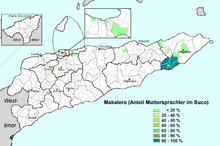Makalero dialect
Makalero or Maklere is a Papuan language spoken in the Lautém district of East Timor. It was previously considered to be a dialect of Makasae, but is nowadays seen as a separate language, both by its speakers and linguists.[1]
| Makalero | |
|---|---|
| Native to | East Timor |
| Region | Timor Island, eastern end around Baucau and inland, west of Fataluku, from northern to southern coast in a dialect chain. |
Native speakers | 8,000 (2017)[1] |
Trans–New Guinea ?
| |
| Language codes | |
| ISO 639-3 | mjb |
| Glottolog | makl1245[2] |
 Distribution of Makalero mother-tongue speakers in East Timor | |
| Coordinates: 8°39′S 126°30′E | |
Phonology
The data in this section are from Huber (2017).[1]
Consonants
Makalero has 11 native consonant phonemes.
| Labial | Alveolar | Post-alveolar | Velar | Glottal | ||||||
|---|---|---|---|---|---|---|---|---|---|---|
| Plosive | p | t | d | k | ʔ | |||||
| Fricative | f | s | ||||||||
| Nasal | m | n | ||||||||
| Trill | r | |||||||||
| Lateral approximant | l | |||||||||
Vowels
Monophthongs
Makalero has five vowel phonemes. Most long vowels occur in predictable contexts; thus Huber argues long vowels are marginal phonemes at best.
| Front | Central | Back | |
|---|---|---|---|
| Close | i (i:) | u (u:) | |
| Mid | e (e:) | o (o:) | |
| Open | a (a:) |
Syllables are commonly CV; some are CVC. Epenthetic vowels are often inserted between series of two consonants, and echo vowels are often added to the end of phonological phrases.
Grammar
All information in this section is from Huber 2011.[3]
Lexical Categories
Makalero does not have a definitive noun/verb distinction. Nearly all content words can be heads of NPs as well as predicates. In the following examples, isit can be a predicate or a nominal.
asi-atupusi hai nomo isit[3]:98 1s:POSS-belly NSIT NEG ill 'my belly did not hurt anymore'
Ki-isit=ee hai k-ua-misa[3]:98 3:POSS-ill=DEF NSIT 3:UND-on.top:RED-go.up 'His illness got worse' (lit. went up on top)
Content words must be bimoraic, unlike function words, which may be monomoraic.
Valency
Makalero has only avalent verbs and divalent verbs. There are no trivalent verbs; instead, biclausal constructions are used.
The avalent verbs are adverbial verbs such as atanana 'first,' hana’e 'a long time ago,' aire’ 'now,' kamunei 'tomorrow,' mu’it 'for a long time,' raine’ 'last night,' and tone’ 'maybe.'
Divalent verbs allow for a subject and either an object or complement.
In the following example, Kiloo is the subject and ani is the object.
Kiloo ani pase[3]:143 3s 1s beat 'He beat me'
In the following example, ani is the subject and rau-rau is the complement.
Ani mei=ni rau-rau-kena[3]:143 1s take=LNK1 RDL-good-see:BD 'I see it very well'
Numerals
- unu - One
- loloi - Two
- lolitu - Three
- faata - Four
- lima - Five
- douhu - Six
- fitu - Seven
- afo - Eight
- siwa - Nine
- ruru-u - Ten
- ruu resi nu - Eleven
- ruu resi loloi - Twelve
- ruu resi lolitu - Thirteen
- ruu resi faata - Fourteen
- ruu resi lima - Fifteen
Notes
- Huber (2017)
- Hammarström, Harald; Forkel, Robert; Haspelmath, Martin, eds. (2017). "Maklere". Glottolog 3.0. Jena, Germany: Max Planck Institute for the Science of Human History.
- Huber (2011)
References
- Huber, Juliette (2011). A grammar of Makalero - A Papuan language of East Timor (Doctoral thesis). Utrecht: LOT (Leiden University). hdl:1887/17684. ISBN 9789460930607.CS1 maint: ref=harv (link)
- Huber, Juliette (2017). "5. Makalero and Makasae". In Schapper, Antoinette (ed.). The Papuan Languages of Timor, Alor and Pantar. Pacific Linguistics 655. volume 2. Walter de Gruyter. pp. 267–351. doi:10.1515/9781614519027-005. ISBN 9781614519027.CS1 maint: ref=harv (link)